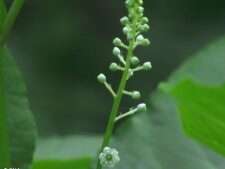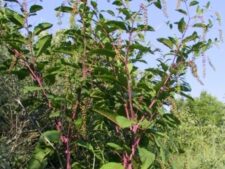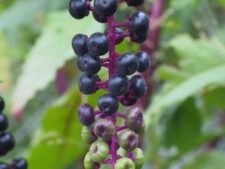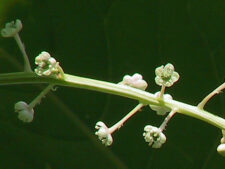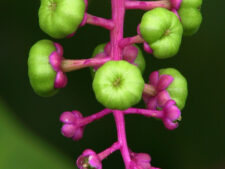
POKEWEED
Phytolacca americana
POKEWEED FAMILY (Phytolaccaceae)
 Identification
Identification
- Flowering time - June, July, August, September
- Common in disturbed areas and open woodlands at FF and NW
- Stout reddish purple stems
- Elongated white, greenish white or pink flower clusters
- Drooping clusters of shiny purple berries
This sturdy, poisonous native perennial grows from 4-10 tall. Stems of young plants are green, but as they mature their stout stems turn a characteristic deep red to reddish purple (C,D). Alternate leaves are large and lance-shaped with smooth or shallowly lobed margins (D). The small white, greenish white (F) or pink (G) flowers with 5 petal-like sepals are on elongated clusters (racemes) (A,B). The fruit hangs in drooping clusters, first green, then a shiny dark purple, with hot pink stalks when ripe (C,D,H).
Pokeweed, native to southeast Nebraska, is a relatively recent addition to our flora. A publication on Fontenelle Forest flora in 1959 produced by the Omaha Botany Club does not mention it. By the time of Marjorie Garabrandt’s 1988 inventory it was listed as common in Fontenelle Forest, but rare at Neale Woods. It is now common along trails, roadsides, in thickets, woodland edges and openings at both sites.
Flowering occurs from June to September.
All parts of Pokeweed are toxic to humans and other animals. Fatal cases of human poisoning have occurred. Fruits, however, are eaten by a variety of songbirds who seem immune to its toxic brew of chemicals.
The berry juice has been used to make dyes and ink, hence the alternate common name, Inkberry.
The content of NatureSearch is provided by dedicated volunteer Naturalists of Fontenelle Forest who strive to provide the most accurate information available. Contributors of the images retain their copyrights. The point of contact for this page is: Roland Barth.

